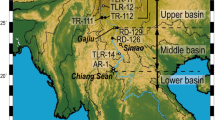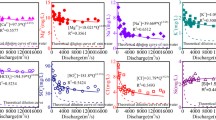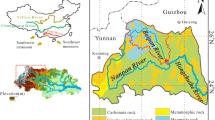Abstract
Feedback between hydrologic variations and chemical weathering is thought to play a crucial role in modulating global carbon cycling. The mechanisms associated with the impacts of hydrologic variations on solute sources and chemical weathering were evaluated by examining the relationships between river discharge and hydrochemistry based on high-frequency sampling of the Min River, which originates in the Himalayan–Tibetan region. Fluid transit times and flow pathways vary with changes in discharge, thereby affecting various biogeochemical processes. Although shorter transit times occur during the high-flow season than during the low-flow season, concentrations of chemical weathering products exhibit chemostatic behaviour (less variation than changes in discharge) in response to increasing discharge due to hydrologic flushing of minerals, which increases the amount of reactive mineral surface area. The contributions of various sources to dissolved loads in the Min River were estimated using a forward model. The calculated annual carbonate and silicate weathering fluxes are 24.1 and 9.6 t/km2 year, respectively. Atmospheric contributions increase with increasing discharge, whereas the contributions of silicate weathering decrease with increasing discharge. Both the carbonate weathering flux (FCarb) and silicate weathering flux (FSil) are positively correlated with the discharge, indicating that temporal variations in chemical weathering fluxes in the Min River are highly affected by hydrologic variations. The slope of the relationship between FCarb and discharge is much greater than that between FSil and discharge due to the rapid dissolution of carbonate minerals, suggesting that carbonate weathering is more sensitive than silicate weathering to hydrologic variations. This study demonstrates that high-frequency sampling is necessary when investigating solute sources and chemical weathering processes in river basins influenced by a monsoon climate.







Similar content being viewed by others
References
Basu NB, Destouni G, Jawitz JW, Thompson SE, Loukinova NV, Darracq A, Zanardo S, Yaeger M, Sivapalan M, Rinaldo A, Rao PSC (2010) Nutrient loads exported from managed catchments reveal emergent biogeochemical stationarity. Geophys Res Lett 37:L23404. doi:10.1029/2010GL045168
Berner RA, Caldeira K (1997) The need for mass balance and feedback in the geochemical carbon cycle. Geology 25:955. doi:10.1130/0091-7613(1997)025<0955:TNFMBA>2.3.CO;2
Boy J, Valarezo C, Wilcke W (2008) Water flow paths in soil control element exports in an Andean tropical montane forest. Eur J Soil Sci 59:1209–1227. doi:10.1111/j.1365-2389.2008.01063.x
Calmels D, Galy A, Hovius N, Bickle M, West AJ, Chen M-C, Chapman H (2011) Contribution of deep groundwater to the weathering budget in a rapidly eroding mountain belt, Taiwan. Earth Planet Science Lett 303:48–58. doi:10.1016/j.epsl.2010.12.032
Chalk PM, Inácio CT, Urquiaga S, Chen D (2015) 13C isotopic fractionation during biodegradation of agricultural wastes. Isot Environ Health Stud 51:201–213. doi:10.1080/10256016.2015.1019488
Chapman H, Bickle M, Thaw SH, Thiam HN (2015) Chemical fluxes from time series sampling of the Irrawaddy and Salween Rivers, Myanmar. Chem Geol 401:15–27. doi:10.1016/j.chemgeo.2015.02.012
Chen J, Wang F, Xia X, Zhang L (2002) Major element chemistry of the Changjiang (Yangtze River). Chem Geol 187:231–255. doi:10.1016/S0009-2541(02)00032-3
Chetelat B, Liu C-Q, Zhao ZQ, Wang QL, Li SL, Li J, Wang BL (2008) Geochemistry of the dissolved load of the Changjiang Basin rivers: anthropogenic impacts and chemical weathering. Geochim Cosmochim Acta 72:4254–4277. doi:10.1016/j.gca.2008.06.013
Clow DW, Mast MA (2010) Mechanisms for chemostatic behavior in catchments: implications for CO2 consumption by mineral weathering. Chem Geol 269:40–51. doi:10.1016/j.chemgeo.2009.09.014
Douglas TA (2006) Seasonality of bedrock weathering chemistry and CO2 consumption in a small watershed, the White River, Vermont. Chem Geol 231:236–251. doi:10.1016/j.chemgeo.2006.01.024
Edmond JM, Palmer MR, Measures CI, Grant B, Stallard RF (1995) The fluvial geochemistry and denudation rate of the Guayana Shield in Venezuela, Colombia, and Brazil. Geochim Cosmochim Acta 59:3301–3325. doi:10.1016/0016-7037(95)00128-M
Gabet EJ, Edelman R, Langner H (2006) Hydrological controls on chemical weathering rates at the soil-bedrock interface. Geology 34:1065. doi:10.1130/G23085A.1
Gaillardet J, Dupré B, Louvat P, Allègre CJ (1999) Global silicate weathering and CO2 consumption rates deduced from the chemistry of large rivers. Chem Geol 159:3–30. doi:10.1016/S0009-2541(99)00031-5
Galy A, France-Lanord C (1999) Weathering processes in the Ganges–Brahmaputra basin and the riverine alkalinity budget. Chem Geol 159:31–60. doi:10.1016/S0009-2541(99)00033-9
Gao Q, Tao Z, Huang X, Nan L, Yu K, Wang Z (2009) Chemical weathering and CO2 consumption in the Xijiang River basin, South China. Geomorphology 106:324–332. doi:10.1016/j.geomorph.2008.11.010
Gascuel-Odoux C, Aurousseau P, Durand P, Ruiz L, Molenat J (2010) The role of climate on inter-annual variation in stream nitrate fluxes and concentrations. Sci Total Environ 408:5657–5666. doi:10.1016/j.scitotenv.2009.05.003
Gislason SR, Oelkers EH, Eiriksdottir ES, Kardjilov MI, Gisladottir G, Sigfusson B, Snorrason A, Elefsen S, Hardardottir J, Torssander P, Oskarsson N (2009) Direct evidence of the feedback between climate and weathering. Earth Planet Science Lett 277:213–222. doi:10.1016/j.epsl.2008.10.018
Godsey SE, Kirchner JW, Clow DW (2009) Concentration-discharge relationships reflect chemostatic characteristics of US catchments. Hydrol Process 23:1844–1864. doi:10.1002/hyp.7315
Han G, Liu C-Q (2004) Water geochemistry controlled by carbonate dissolution: a study of the river waters draining karst-dominated terrain, Guizhou Province, China. Chem Geol 204:1–21. doi:10.1016/j.chemgeo.2003.09.009
Hren MT, Chamberlain CP, Hilley GE, Blisniuk PM, Bookhagen B (2007) Major ion chemistry of the Yarlung Tsangpo–Brahmaputra River: chemical weathering, erosion, and CO2 consumption in the southern Tibetan Plateau and eastern syntaxis of the Himalaya. Geochim Cosmochim Acta 71:2907–2935. doi:10.1016/j.gca.2007.03.021
Huang L (2015) Chemical weathering in the Three Rivers region of southwestern China. University of Chinese Academy of Sciences, Master Thesis
Humborg C, Ittekkot V, Cociasu A, Bodungen VB (1997) Effect of Danube River dam on Black Sea biogeochemistry and ecosystem structure. Nature 386:385–388
Karim A, Veizer J (2000) Weathering processes in the Indus River Basin: implications from riverine carbon, sulfur, oxygen, and strontium isotopes. Chem Geol 170:153–177. doi:10.1016/S0009-2541(99)00246-6
Li S, Chetelat B, Yue F, Zhao Z, Liu C-Q (2014a) Chemical weathering processes in the Yalong River draining the eastern Tibetan Plateau, China. J Asian Earth Sci 88:74–84. doi:10.1016/j.jseaes.2014.03.011
Li S, Lu XX, Bush RT (2014b) Chemical weathering and CO2 consumption in the Lower Mekong River. Sci Total Environ 472:162–177. doi:10.1016/j.scitotenv.2013.11.027
Li X, Gan Y, Zhou A, Liu Y (2015) Relationship between water discharge and sulfate sources of the Yangtze River inferred from seasonal variations of sulfur and oxygen isotopic compositions. J Geochem Explor 153:30–39. doi:10.1016/j.gexplo.2015.02.009
Maher K (2011) The role of fluid residence time and topographic scales in determining chemical fluxes from landscapes. Earth Planet Science Lett 312:48–58. doi:10.1016/j.epsl.2011.09.040
Maher K, Chamberlain CP (2014) Hydrologic regulation of chemical weathering and the geologic carbon cycle. Science 343:1502–1504. doi:10.1126/science.1250770
Meybeck M (1993) Riverine transport of atmospheric carbon: sources, global typology and budget. Water Air Soil Pollut 70:443–463. doi:10.1007/BF01105015
Meybeck M (2003) 5.08 - Global occurrence of major elements in rivers A2 - Holland, Heinrich D. In: Turekian KK (ed) Treatise on geochemistry. Pergamon, Oxford, pp 207–223
Millot R, Jé G, Dupré B, Allègre CJ (2003) Northern latitude chemical weathering rates: clues from the Mackenzie River Basin, Canada. Geochim Cosmochim Acta 67:1305–1329. doi:10.1016/S0016-7037(02)01207-3
Moon S, Chamberlain CP, Hilley GE (2014) New estimates of silicate weathering rates and their uncertainties in global rivers. Geochim Cosmochim Acta 134:257–274. doi:10.1016/j.gca.2014.02.033
Moon S, Huh Y, Qin J, van Pho N (2007) Chemical weathering in the Hong (Red) River basin: rates of silicate weathering and their controlling factors. Geochim Cosmochim Acta 71:1411–1430. doi:10.1016/j.gca.2006.12.004
Moquet JS, Guyot JL, Crave A, Viers J, Filizola N, Martinez JM, Oliveira TC, Sánchez LS, Lagane C, Casimiro WS, Noriega L, Pombosa R (2016) Amazon River dissolved load: temporal dynamics and annual budget from the Andes to the ocean. Environ Sci Pollut Res Int 23:11405–11429. doi:10.1007/s11356-015-5503-6
Natali C, Bianchini G, Marchina C, Knöller K (2016) Geochemistry of the Adige River water from the Eastern Alps to the Adriatic Sea (Italy): evidences for distinct hydrological components and water-rock interactions. Environ Sci Pollut Res Int 23:11677–11694. doi:10.1007/s11356-016-6356-3
Noh H, Huh Y, Qin J, Ellis A (2009) Chemical weathering in the Three Rivers region of Eastern Tibet. Geochim Cosmochim Acta 73:1857–1877. doi:10.1016/j.gca.2009.01.005
Qin J, Huh Y, Edmond JM, Du G, Ran J (2006) Chemical and physical weathering in the Min Jiang, a headwater tributary of the Yangtze River. Chem Geol 227:53–69. doi:10.1016/j.chemgeo.2005.09.011
Sarin MM, Krishnaswamy S, Dilli K, Somayajulu BLK, Moore WS (1989) Major ion chemistry of Ganga–Brahmaputra river system: weathering processes and fluxes of the Bay of Bengal. Geochim Cosmochim Acta 53:997–1009
Singh SK, Sarin MM, France-Lanord C (2005) Chemical erosion in the eastern Himalaya: major ion composition of the Brahmaputra and δ13C of dissolved inorganic carbon. Geochim Cosmochim Acta 69:3573–3588. doi:10.1016/j.gca.2005.02.033
Thompson SE, Basu NB, Lascurain J, Aubeneau A, Rao PSC (2011) Relative dominance of hydrologic versus biogeochemical factors on solute export across impact gradients. Water Resour Res 47:WOOJ05. doi: 10.1029/2010WR009605
Tipper ET, Bickle MJ, Galy A, West AJ, Pomiès C, Chapman HJ (2006) The short term climatic sensitivity of carbonate and silicate weathering fluxes: insight from seasonal variations in river chemistry. Geochim Cosmochim Acta 70:2737–2754. doi:10.1016/j.gca.2006.03.005
Torres MA, West AJ, Clark KE (2015) Geomorphic regime modulates hydrologic control of chemical weathering in the Andes–Amazon. Geochim Cosmochim Acta 166:105–128. doi:10.1016/j.gca.2015.06.007
Wang L, Zhang L, Cai W-J, Wang B, Yu Z (2016) Consumption of atmospheric CO2 via chemical weathering in the Yellow River basin: the Qinghai–Tibet Plateau is the main contributor to the high dissolved inorganic carbon in the Yellow River. Chem Geol 430:34–44. doi:10.1016/j.chemgeo.2016.03.018
White AF, Blum AE (1995) Effects of climate on chemical_ weathering in watersheds. Geochim Cosmochim Acta 59:1729–1747
Wu L, Huh Y, Qin J, Du G, van Der Lee S (2005) Chemical weathering in the Upper Huang He (Yellow River) draining the eastern Qinghai-Tibet Plateau. Geochim Cosmochim Acta 69:5279–5294. doi:10.1016/j.gca.2005.07.001
Wu W (2016) Hydrochemistry of inland rivers in the north Tibetan Plateau: constraints and weathering rate estimation. Sci Total Environ 541:468–482. doi:10.1016/j.scitotenv.2015.09.056
Wu W, Xu S, Yang J, Yin H (2008) Silicate weathering and CO2 consumption deduced from the seven Chinese rivers originating in the Qinghai-Tibet Plateau. Chem Geol 249:307–320. doi:10.1016/j.chemgeo.2008.01.025
Xiao J, Jin ZD, Wang J, Zhang F (2015) Hydrochemical characteristics, controlling factors and solute sources of groundwater within the Tarim River Basin in the extreme arid region, NW Tibetan Plateau. Quaternary Int 380-381:237–246
Xiao J, Zhang F, Jin Z (2016) Spatial characteristics and controlling factors of chemical weathering of loess in the dry season in the middle Loess Plateau, China. Hydrol Process 30:4855–4869
Yoon J, Huh Y, Lee I, Moon S, Noh H, Qin J (2008) Weathering processes in the Min Jiang: major elements, 87Sr/86Sr, δ34SSO4 and δ18OSO4. Aquat Geochem 14:147–170. doi:10.1007/s10498-008-9030-7
Zhong J, Li SL, Tao F, Yue F, Liu CQ (2017) Sensitivity of chemical weathering and dissolved carbon dynamics to hydrological conditions in a typical karst river. Sci Rep 7:42944. doi:10.1038/srep42944
Acknowledgements
This work was financially supported by National Natural Science Foundation of China (Grants 41422303 and 41130536) and the Ministry of Science and Technology of China (Grants 2016YFA0601000 and 2013CB956700).
Author information
Authors and Affiliations
Corresponding author
Additional information
Responsible editor: Boqiang Qin
Electronic supplementary material
ESM 1
(DOCX 371 kb)
Rights and permissions
About this article
Cite this article
Zhong, J., Li, Sl., Tao, F. et al. Impacts of hydrologic variations on chemical weathering and solute sources in the Min River basin, Himalayan–Tibetan region. Environ Sci Pollut Res 24, 19126–19137 (2017). https://doi.org/10.1007/s11356-017-9584-2
Received:
Accepted:
Published:
Issue Date:
DOI: https://doi.org/10.1007/s11356-017-9584-2




